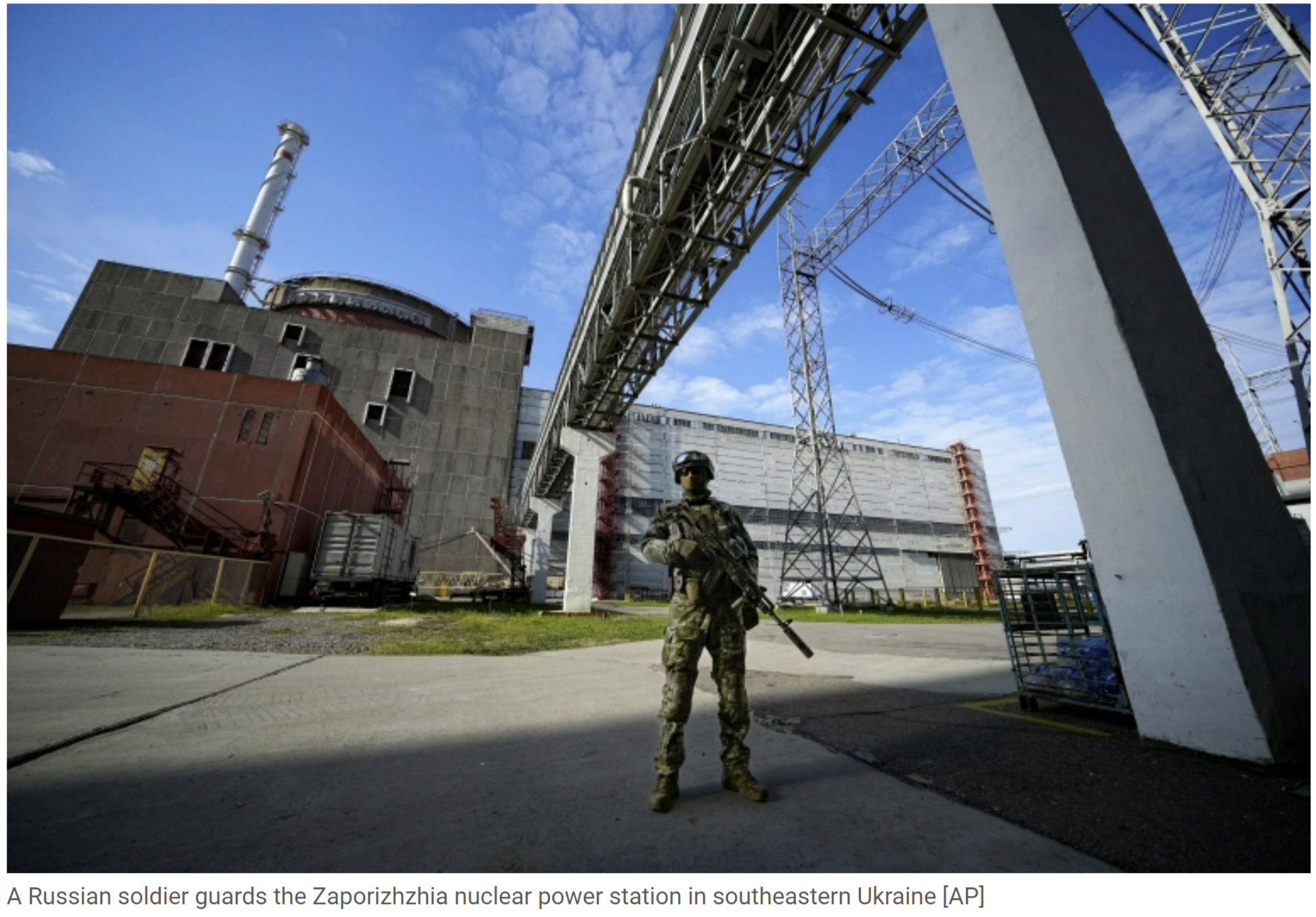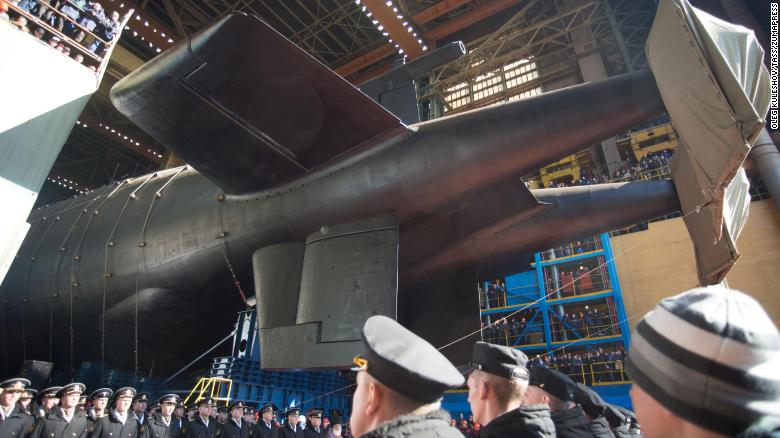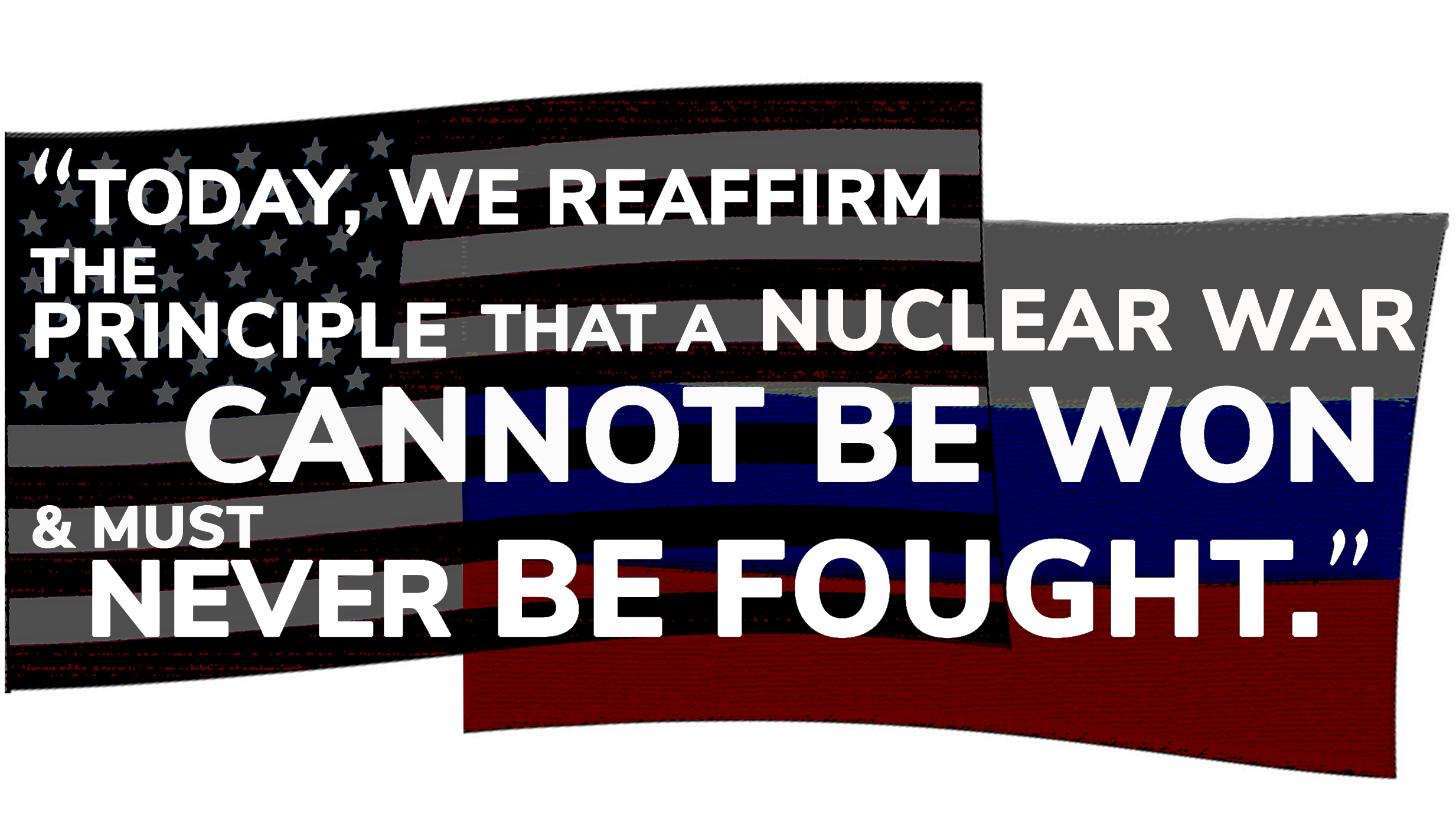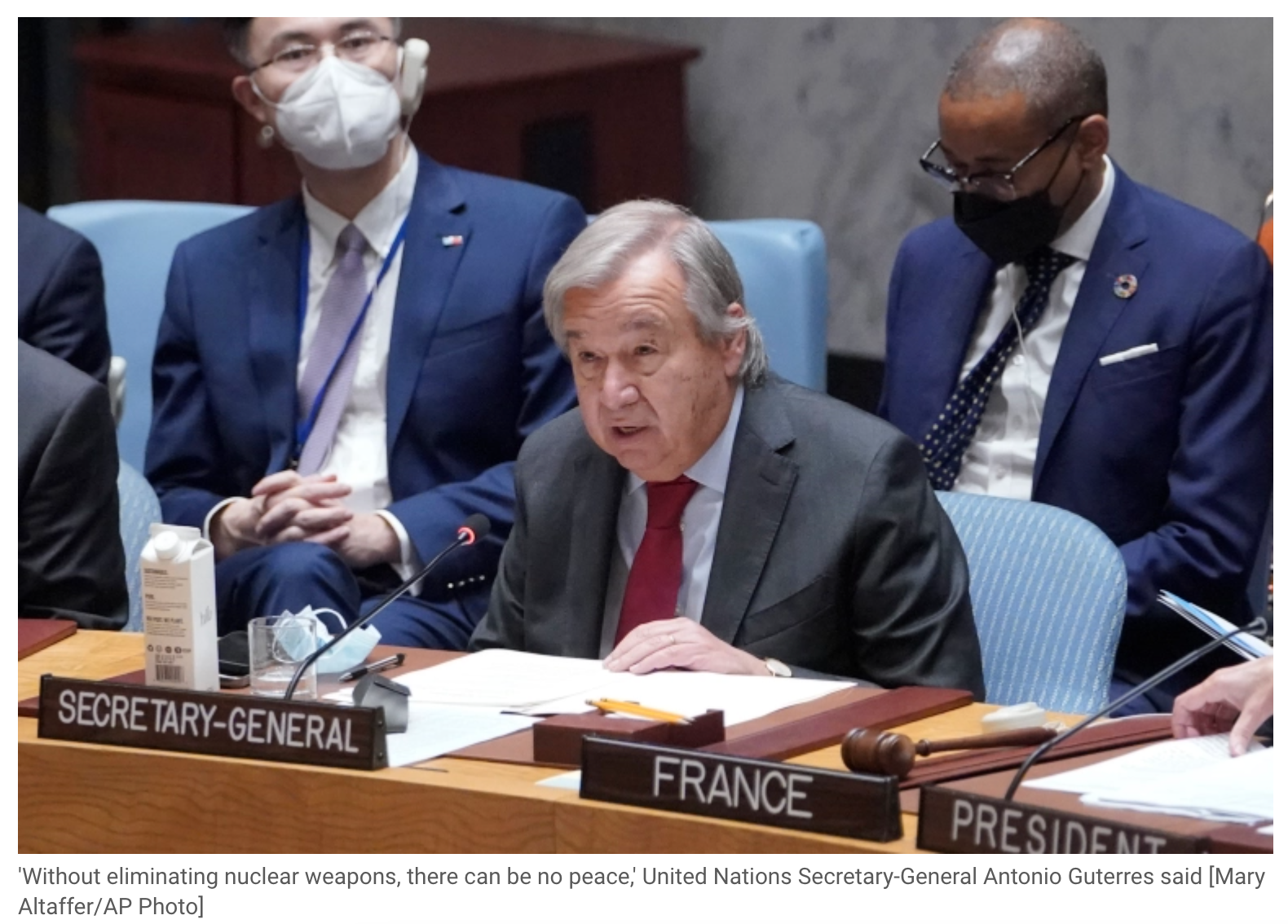Sullivan has held talks with Putin aides amid nuclear fears: WSJ
“White House national security adviser Jake Sullivan has held talks with top aides to Russian President Vladimir Putin amid rising tensions between Washington and Moscow in recent weeks, according to the Wall Street Journal.
“After a series of setbacks in Ukraine, Putin has signaled that he was willing to use nuclear weapons to defend Russia, causing Biden to warn of a nuclear ‘Armageddon.’”
THE HILL | BRAD DRESS | November 6, 2022 thehill.com
U.S. officials and allies told the news outlet that Sullivan has been in talks with Yuri Ushakov, a foreign-policy adviser to Putin, as well as Nikolai Patrushev, head of Russia’s security council.
It’s unclear how many times Sullivan has spoken with the officials, but the conversations have been focused on preventing escalation of the war as fears of Russia using nuclear weapons have been rising, according to the Wall Street Journal.
UN chief calls for end to ‘era of nuclear blackmail’
Guterres renews call for the abolition of nuclear weapons as concerns grow over Russia’s threat to use them in Ukraine.
ALJAZEERA | September 26, 2022 aljazeera.com
United Nations Secretary-General Antonio Guterres has renewed his call for the global abolition of nuclear weapons as concerns grow over Russia’s threat to use them in the Ukraine war.
“Decades after the fall of the Berlin Wall, we can hear once again the rattling of nuclear sabres,” Guterres told a special UN General Assembly session on nuclear disarmament on Monday.
Nuke waste managers work to improve safety after incidents at repository near Carlsbad
Crews at Idaho National Laboratory and the Waste Isolation Pilot Plant nuclear waste repository near Carlsbad met last week to improve safety standards shared between the two facilities after a string of problematic waste shipments from the lab triggered a state investigation.
Adrian Hedden, Carlsbad Current-Argus | September 22, 2022 yahoo.com
So far this year, WIPP personnel were alerted to issues with three shipments of transuranic (TRU) nuclear waste from the Idaho lab, leading to suspensions of waste shipments from the biggest shipper of waste to WIPP.
The first incident was reported on April 9, per a letter from the New Mexico Environment Department which regulates the U.S. Department of Energy’s permit to operate WIPP, and involved a liquid substance found on a waste drum that initially tested positive for radioactivity.
This led to an evacuation of the waste handling building, and a temporary halt on shipments of that kind from Idaho National Laboratory while the waste was sent back to Idaho.
Fighting rages near Russian-held nuclear plant in Ukraine
An official says the besieged Zaporizhzhia nuclear facility may be closed as residents near the plant are urged to evacuate for their own safety.
ALJAZEERA | September 9, 2022 aljazeera.com
 Heavy fighting erupted in areas near the Russian-occupied Zaporizhzhia nuclear power station in Ukraine after Kyiv warned it might have to shut down the plant to avoid a radiation disaster.
Heavy fighting erupted in areas near the Russian-occupied Zaporizhzhia nuclear power station in Ukraine after Kyiv warned it might have to shut down the plant to avoid a radiation disaster.
The General Staff of the Ukrainian Armed Forces said in its daily update on Thursday that some villages near the plant were bombed over the past 24 hours by “tanks, mortars, barrel and jet artillery”.
Overnight, Russian forces fired rockets and heavy artillery into the nearby town of Nikopol four times, the area’s regional governor, Valentyn Reznichenko, wrote on Telegram, damaging at least 11 houses and other buildings.
On Wednesday, an official said the nuclear plant may have to be shut down and called on residents in areas near the embattled facility to evacuate for their own safety.
Shelling at Ukrainian nuclear plant highlights danger ahead of UN report – Reuters
U.N. seeks security zone near damaged Zaporozhzhia nuclear plant
By Pavel Polityuk and Francois Murphy, Reuters | September 6, 2022 reuters.com
Federal agents seized the document during their search of Mar-a-Lago, the former president’s Palm Beach mansion in Florida, last
KYIV/VIENNA, Sept 6 (Reuters) – Ukrainian forces shot down five Russian cruise missiles on Tuesday, most of them in the south, President Volodymyr Zelenskiy said, but he made no mention of a new military success in the east hinted at by officials earlier.
“This morning alone, five of six Russian X-101 missiles were downed,” Zelenskiy said in an evening address. “This is a costly loss for Russia, and it saves many Ukrainian lives. Four of these missiles were downed by the “South” district of the air command.”
Reuters was not able to independently verify Zelenskiy’s statement and there was no immediate response from Russia.
Though Ukrainian officials did not give specific details, several posts on social media from military bloggers and witnesses reported fighting around Balakliia, an eastern town of 27,000 people that lies between Kharkiv and Russian-held Izyum, a city with a major railway hub used by Moscow to supply its forces. One tweet by a Zelenskiy adviser spoke of “great news” coming from the president on the operation in Kharkiv region.
The weight of a butterfly
“Of the 64 kilograms of uranium in the Hiroshima bomb, less than one kilogram underwent fission, and the entire energy of the explosion came from just over half a gram of matter that was converted to energy.
That is about the weight of a butterfly.”
By Emily Strasser, Bulletin of the Atomic Scientists | August 6, 2022 thebulletin.org
The design for the first atomic bomb was frighteningly simple: One lump of a special kind of uranium, the projectile, was fired at a very high speed into another lump of that same rare uranium, the target. When the two collided, they began a nuclear chain reaction, and it was only a tiny fraction of a second before the bomb exploded, forever splitting history between the time before the atomic bomb and the time after.
At 17 seconds past 8:15 a.m. on August 6, 1945, the Enola Gay released the bomb from a height of 31,600 feet above the target, a T-shaped bridge in the center of Hiroshima, Japan.
The morning was cloudless, as the weather plane sent to scout for the Enola Gay had reported in the hour before. If the weather had been poor, the plane would have set its course to one of the two alternate targets. As the bomb fell, a schoolboy closed his eyes and began to count as his friends hid along the way to school.
Nuclear threat higher now than in Cold War, British official warns
“’We are entering a dangerous new age,’ [Lovegrove] added, citing the spread of advanced weapons and cyberwarfare.”
BY Ellen Francis © WASHINGTON POST | July 28, 2022 washingtonpost.com
Britain’s national security adviser has warned that a breakdown in dialogue among rival powers is raising the risk of nuclear war, with fewer safeguards now than during the Cold War.
As such, he said, Britain strongly supports President Biden’s talking with Beijing.
Nuclear strategy and ending the war in Ukraine
“Removing U.S. nuclear weapons from Europe and Turkey would not weaken NATO militarily, since nuclear weapons have little or no actual usefulness on the battlefield. If they are truly weapons of last resort, there is no need to deploy them so close to Russia’s border. ”
A bold idea: NATO offers to withdraw nukes from Europe (militarily useless, ineffective deterrents as we’ve just seen, & recklessly dangerous) in return for ending the invasion. Putin gets a “win” which costs us nothing worth having. https://t.co/P5txyLEcMs
— Steven Pinker (@sapinker) July 25, 2022
BY OSCAR ARIAS AND JONATHAN GRANOFF, The Hill | July 25, 2022 thehill.com
It is time for bolder efforts to make peace in Ukraine.
War, like fire, can spread out of control, and as President Putin keeps reminding us, this particular conflagration has the potential to start a nuclear war.
At a recent joint news conference with the President of Belarus, Putin announced that Russia would transfer Iskander M missiles to Belarus. Those missiles can carry nuclear warheads, and the move is apparently intended to mirror nuclear sharing arrangements the United States has with five NATO allies — Belgium, the Netherlands, Germany, Italy, and Turkey.
U.S. nuclear weapons were introduced into Europe in the 1950s as a stopgap measure to defend NATO democracies whose conventional forces were weak. The number of nuclear weapons in those five countries peaked around 7,300 warheads in the 1960s, then dwindled to about 150 today, reflecting NATO’s growing conventional strength and its diminishing estimation of the military usefulness of nuclear weapons. But even 150 nuclear weapons could be more than sufficient to touch off a dangerous confrontation with Russia.
CNN – Russian Navy’s massive submarine could set the stage for ‘a new Cold War’ in the oceans
“Both US and Russian officials have said the torpedoes could deliver warheads of multiple megatons, causing radioactive waves that would render swathes of the target coastline uninhabitable for decades.”
By Brad Lendon, CNN, CNN | July 23, 2022 cnn.com

Seoul, South Korea (CNN) The Russian Navy has taken delivery of what is the world’s longest known submarine, one its maker touts as a research vessel — but what others say is a platform for espionage and possibly nuclear weapons.
The Belgorod was turned over to the Russian Navy earlier this month in the port of Severodvinsk, according to the country’s largest shipbuilder, Sevmash Shipyard.
Experts say its design is a modified version of Russia’s Oscar II class guided-missile submarines, made longer with the aim to eventually accommodate the world’s first nuclear-armed stealth torpedoes and equipment for intelligence gathering.
If the Belgorod can successfully add those new capabilities to the Russian fleet, it could in the next decade set the stage for a return to scenes of the Cold War under the ocean, with US and Russian subs tracking and hunting each other in tense face-offs.


